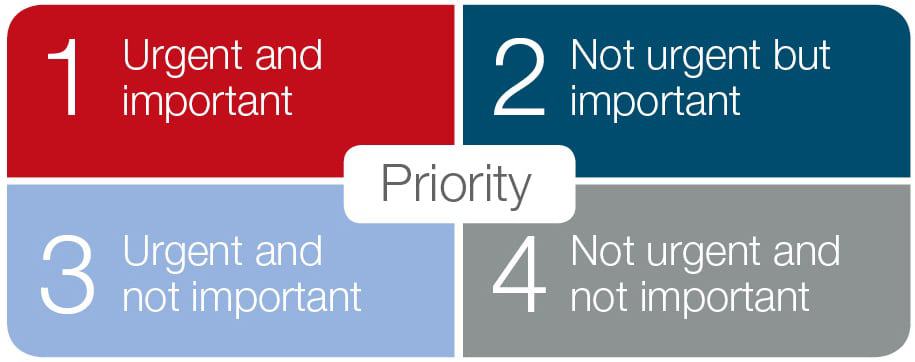Many of the clients I coach have a challenge in getting through their huge workloads. They regularly feel overwhelmed, accompanied by a sense of frustration.
I hear the following similar complaints all the time:
“I’m smart – why can’t I get all of this stuff done and get out of the office at a reasonable time?”
“Everything sent to me is an urgent priority! It can’t all be urgent.”
“I’m too busy putting out other people’s fires to get my own stuff done.”
“No matter how hard I try, I can’t seem to put a dent in this to-do list”
The core challenge here is prioritisation. Turning our attention to the right things at the right time. Giving them the attention and energy they deserve, while ignoring or postponing other tasks.
Consider both importance and urgency
There are two key concepts: importance and urgency. Sense of importance and urgency are quite subjective and not always shared between people. Consider the last panicky phone call you got from a colleague looking for your help. Sure, they had an urgent request – but was it urgent by your standards? And yes, it was important to them, but did you agree?
Similarly, tasks can be urgent but not important. And important, but not urgent. Urgency and importance can also change over time, which can complicate things. In general, tasks that aren’t urgent but are neglected can often become urgent over time.
This can all seem quite complicated, but if you take your very long list of tasks on your to-do list and actually spread them across a matrix of importance vs urgency, it can really make things clearer. It’s definitely not a new idea – President Eisenhower was said to use this categorisation, which is why it’s still sometimes referred to as an “Eisenhower Matrix”.

Let’s walk through these four quadrants to explore their meaning, what kinds of things end up in that quadrant and how we might handle them.
Quadrant 1: Urgent and Important
This is quite an unconformable quadrant to be in, especially if there are lots of tasks that are both urgent and important. Tasks that have an impending deadline, which are also materially important, end up in this quadrant. The report to the board that’s due at the end of this week. Attending that job interview for the role of your dreams. Booking the flight to attend that important client pitch before all seats are gone.
These are all activities that have a definite ‘drop dead’ time constraint and which if left incomplete, would have a materially negative impact on you, your performance or those that you care about.
Quadrant 2: Not urgent, but Important
This is the quadrant that frequently gets ignored or suffers when we’re under pressure. Activities that sit here include self-development, planning for the medium and longer term, training, team development, personal exercise and well-being. The reason they suffer is because tasks in quadrant 1 can scream “look at me” and we can push quadrant 2 tasks towards some indefinite future point. This is a form of procrastination and sadly, these tasks will slowly but surely move from being important to important and urgent.
Quadrant 2 tasks can be viewed as investments for the future. If you take the time to plan your quarter and your year, you’re less likely to be disorganised and under pressure later on. You’ll have thought through how you’ll spend your time and what you’ll need to do to prepare for known future events.
Your own development and learning is also an investment – it takes time, but pays off in the future.
Quadrant 3: Urgent but not Important
Examples of tasks here include things that are important and urgent to others, but not to you. There’s a sense of urgency communicated by the demand from someone else: a phone call or an email, but you may not necessarily share this perspective. They frequently take the form of interruptions.
These things have the potential to derail your focus and attention and flood your plan with irrelevant or emotionally-charged activities that don’t help you reach your own goals and focus on what you’ve already decided is important to you.
Many tasks which fit into this quadrant are prime candidates for being delegated to someone else, while you retain your focus on priorities.
Quadrant 4: Not Urgent and not Important
Due to the way communications technology works these days (e.g. email), we can be flooded with lots of tasks that sit in this quadrant. They are neither import to you nor have a sense of urgency. But if they sat anywhere near the top of your to-do list, then they would effectively de-prioritise more important tasks.
Distractions, such as social media, or “busy work” (e.g. filing emails in folders) and email chains where someone has unhelpfully used the “reply all” button all fit in this quadrant.
These activities need to be quarantined from your attention and only done either when everything else in the other quadrants has been addressed or when you’re taking a well-earned break from difficult work. Completion of tasks in this quadrant can fool us into believing we’re being productive, while our most important tasks sit untouched and ignored.
In summary
So the lesson here is to think of both urgency and importance when reviewing your to-do list. Regardless of its format, segmenting your actions into priorities along these two criteria can really help you focus productively.
We discussed role of prioritisation on the ‘My Pocket Psych’ podcast, as part of our series on productivity. You can listen in below:

